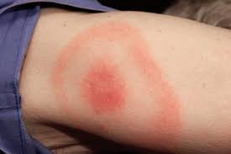Many people with early-stage Lyme disease develop a distinctive circular rash (known as erythema migrans) at the site of the tick bite, usually around 3 to 30 days after being bitten.
Some people also experience flu-like symptoms such as:
- Fatigue
- muscle pain
- joint pain
- headaches
- fever
- chills
- neck stiffness
Late-stage disease can develop months or even years later if Lyme disease is left untreated or if treatment is delayed. Presentations may include inflammatory arthritis, nerve problems (numbness, limb pain, facial palsy and memory problems), cardiac problems, encephalitis and meningitis. A small number of people develop long-term health problems similar to fibromyalgia or chronic fatigue syndrome.
